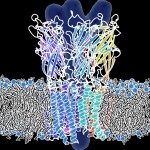Link to Pubmed [PMID] – 15096585
Link to HAL – Click here
Link to DOI – 10.1073/pnas.0400301101
Proc. Natl. Acad. Sci. U.S.A. 2004 May;101(18):6957-62
As more and more structures of macromolecular complexes get solved in different conditions, it has become apparent that flexibility is an inherent part of their biological function. Normal mode analysis using simplified models of proteins such as the elastic network model has proved very effective in showing that many of the structural transitions derived from a survey of the Protein Data Bank can be explained by just a few of the lowest-frequency normal modes. In this work, normal modes are used to carry out medium- or low-resolution structural refinement, enforcing collective and large-amplitude movements that are beyond the reach of existing methods. Refinement is carried out in reciprocal space with respect to the normal mode amplitudes, by using standard conjugate-gradient minimization. Several tests on synthetic diffraction data whose mode concentration follows the one of real movements observed in the Protein Data Bank have shown that the radius of convergence is larger than the one of rigid-body refinement. Tests with experimental diffraction data for the same protein in different environments also led to refined structural models showing drastic reduction of the rms deviation with the target model. Because the structural transition is described by very few parameters, over-fitting of real experimental data is easily detected by using a cross-validation test. The method has also been applied to the refinement of atomic models into molecular envelopes and could readily be used to fit large macromolecular complex rearrangements into cryo-electron microscopy-reconstructed images as well as small-angle x-ray scattering-derived envelopes.

